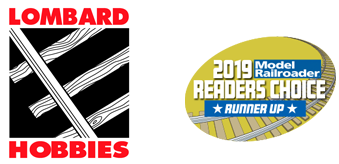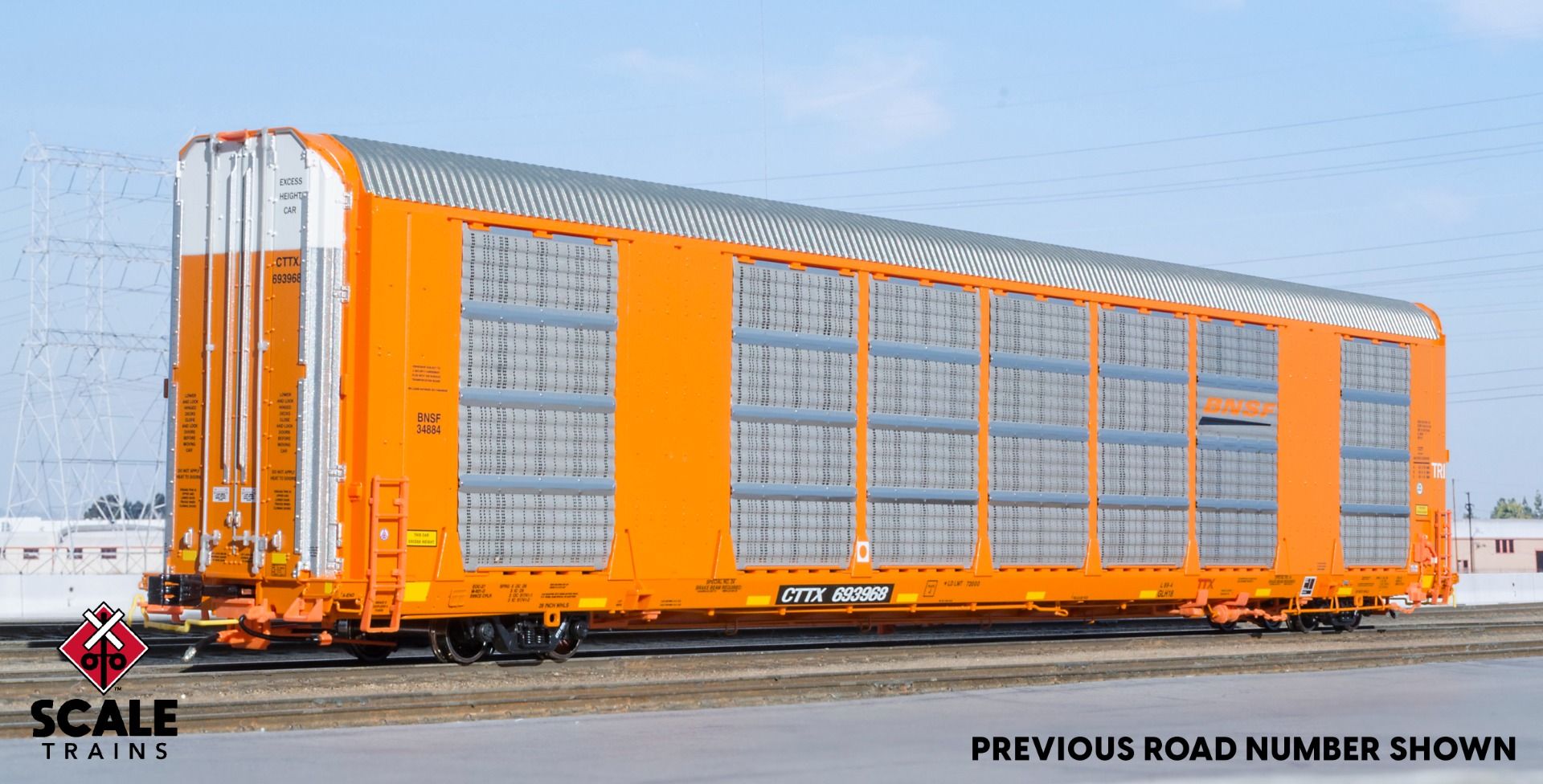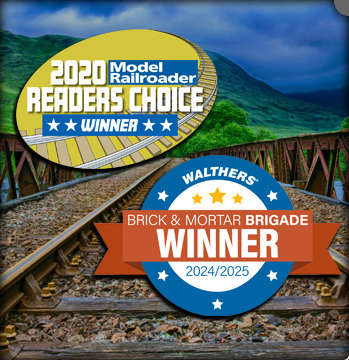ScaleTrains HO
ScaleTrains Rivet Counter HO SXT38858 Gunderson Multi-Max Autorack BNSF Orange Logo TTGX #693963
- In Stock:
- 3
- Scale:
- HO
- SKU:
- SXT38858
- Availability:
- Y
Description
Please note picture is representative of the item but may not be same road number. Always refer to product description for actual product details.
ScaleTrains Rivet Counter HO SXT38858 Gunderson Multi-Max Autorack BNSF Orange Logo TTGX #693963
Road Number Specific ScaleTrains
- New road numbers
- Era: 2015 to present
- BNSF series TTGX 693934-693994, built 10/15
- Road numbers 693942, 693963, 693966, 693972, 693975 and 693983
- Fully-assembled
- Multiple road numbers
- Car rack numbers and ARR rack clearance data is specific to each road number
- Late body type
- 14 photo etched metal side panels
- Sixth corrugated panel row from the left has one solid panel for BNSF/Wedge logo
- Upper side panel mounting with three outside mounting tabs and no strip
- Lower side panel mounting with four lower recessed tabs and ¾ width strip
- Rack stenciled TRI
- Three main bodies of rack mounting holes in painted side panels for trilevel cars
- Late end doors with 'zig-zag' angle panels
- Separate door rods
- End sill step, end sill grab irons, and side sill grab irons
- Low mounted side ladders
- Photo etched metal defect card holder
- Additional tube type defect card holder
- Gunderson builder’s plate
- Factory-applied metal grab irons, coupler cut levers, and trainline hoses
- Outside side sill brake cylinder and brake beam mounting brackets
- Outside side sill brake rod support brackets
- Underbody brake plumbing with separate air reservoir, control valve, and retainer valve plus separately applied wireform plumbing including trainline pipe with brackets
- Semi-scale coupler boxes
- Durable body-mounted die-cast metal semi-scale standard Type E extended shank couplers
- ASF low deck swing motion trucks with finely rendered raised foundry data; Black rotating bearing caps; separate “truck-mounted brake” brake beams; and side bearing detail
- Timken three-sided bearing caps
- Painted reporting mark and road number on all four trucks
- 28” machined metal wheels with accurately profiled .110" wide wheel tread
- Operates on Code 70, 83 and 100 rail
- Printing and lettering legible even under magnification
- FRA-224 yellow conspicuity stripes
- Paint colors match Tru-Color Paint color: Roof TCP-354 galvanized steel
- Weighted to Industry standards for reliable operation
- Packaging safely stores model
- Minimum radius: 24”
- Recommended radius: 26”
PROTOTYPE HISTORY:
Since the development of the automobile, automakers and the railroads have worked together to develop better and more efficient methods for transporting new vehicles. Shipping via rail offered automakers a fast, cost-effective method of moving new autos from manufacturing centers to distribution centers, or in the early days, to dealers themselves. Double-door boxcars were some of the first designs used for shipment of autos; the cars would simply be driven aboard, with the larger opening of the double-doors helping to facilitate this. As time went on, flatcars equipped with multi-level open-air racks for handling autos would be developed. As automobiles are relatively light, long flats of up to 89’ in length would be developed and adapted to use multi-level, for a total of two or three decks, racks, simply known as 'autoracks', hauling up to over a dozen new autos.
While initially successful, by the late 1960s the new vehicles shipped via racks on would prove to be too tempting a target for vandals, who used the windows on new vehicles for target practice using rocks or other, higher-velocity projectiles. Thieves would take a toll as well, breaking into new automobiles to steal high-value components like stereos or hubcaps. Even train-hopping transients would prove to be a problem, since riding in a new automobile would be much more comfortable than a dirty boxcar or gondola. Railroads and car builders would add metal screens or fiberglass panels to the sides of the autoracks, to shield the new vehicles from wayward missiles.
While the side screens or panels worked to protect window glass, the ends of the autoracks were still open, allowing easy access for thieves or transients to climb aboard and damage the new vehicles. The 1970s would see the development of fully-enclosed autoracks to protect this valuable cargo. The sides were completely protected with perforated galvanized-steel panels, the top of the car was enclosed with a galvanized steel roof, which protected cars on the top level, and the ends were equipped with a large pair of sliding or folding doors, helping to keep unwanted passengers out.
As effective as this basic design is, there is always room for improvement. With many racks built in the 60s and 70s nearing the end of their operational lives, in 2013 Gunderson would introduce a new design to provide the ultimate in protection for automobiles, as well as operational flexibility. The new design, dubbed 'Multi-Max', introduced design elements to help meet the challenges faced by railroads and shippers in the 21st century. While the basic enclosed autorack protects new autos from vandal projectiles, a new form of vandalism, graffiti, would become prevalent in the late 90s. The spray-can vandalism would pass through the perforations in the autorack side panels and onto the new autos, ruining their finish. The perforations were a necessity though, to allow enough light for workers loading or unloading the cars, as well as to allow ventilation of automobile exhaust. Multi-Max features smaller, fewer, and more widely spaced perforations in its side panels, reducing the chance of paint spray passing through.
In another novel design feature, the cars feature the ability to adjust the number of decks. 'Bi-level' autoracks are intended to carry taller vehicles, such as SUVs or vans, while 'tri-level' autoracks, having an additional deck, handle shorter-in-height standard or compact autos in the same given space. Traditionally, railroads would order bi- and/or tri-level racks based upon anticipated traffic from manufacturing plants, though if a plant decided to shift production from one vehicle type to another, such as from automobiles, to SUVs, it could result in a surplus of a car type unsuitable for the new traffic. Multi-Max features the ability for railroad car shops to change the car configuration from bi-level to tri-level, or vice-versa, as traffic patterns dictate.
As of this writing, the Gunderson Multi-Max has proven to be an extremely popular design, with thousands built to date for nearly all of the Class One railroads. And in a welcome departure from recent practice, many of these cars wear colorful schemes featuring large logos, making them stand out in a train alongside older autorack designs. With the numbers built to date and its popularity with shippers, the Gunderson Multi-Max appears poised to become the premier autorack design of the 2000s
Lombard Hobbies - Your #1 Largest Authorized ScaleTrains Select Retailer!

























